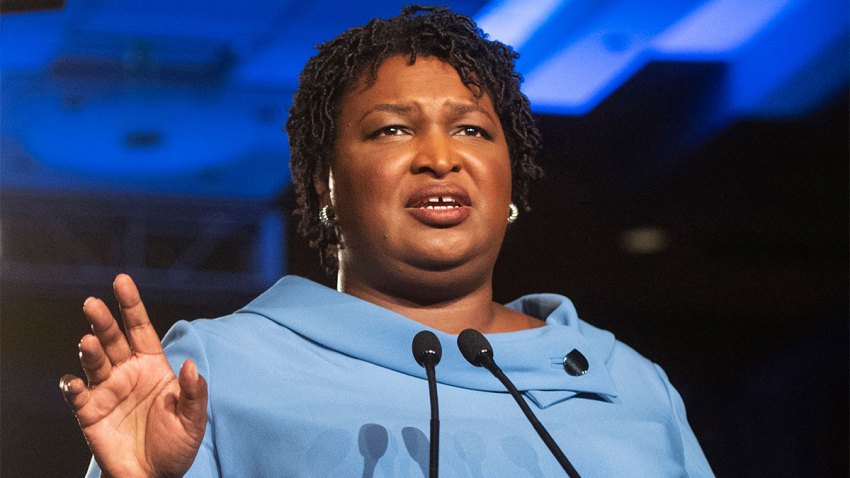MATT ROBISON , PODCAST HOST AND FORMER CONGRESSIONAL STAFFER
Acouple of weeks ago, Stacey Abrams‘ political organization quietly pulled off a political master stroke: Her organization wiped out $212 million in medical debt for 108,000 people across five states. But Ms. Abrams didn’t only profoundly help a lot of Americans; she also created a blueprint for a more effective form of American politics. The question is whether Democrats are paying attention.
And they need to be—badly. The coming years will be rough no matter what the Democrats do, and they could be downright disastrous for our country. History says the Dems should lose around 37 seats in the House next year. They face tough odds in the Senate. State legislatures and governorships are tilting away from them. And Republican mapmaking advantages could help to lock in wins for the remainder of the decade.
But that’s only half the problem. There are also structural advantages like the fact that Republicans get half the votes in the Senate for representing just 43 percent of the country, as well as an enthusiasm gap; in the recent Virginia and New Jersey elections, Democratic candidates actually exceeded their vote totals from the previous election—but Republicans still exceeded them by way more. Together, this means that Democrats don’t need to match Republican voter enthusiasm to win; they need to lap it.
Unfortunately, just trying to persuade the voters who usually show up in elections won’t cut it, not when so few voters are willing to flip between the parties—under 10 percent. So the only way to have a prayer is to bring in lots of voters off the sidelines, both by re-engaging infrequent voters who turned out for President Biden and by creating additional waves of new voters who have never cast a ballot before.
But to do that, the usual tools are surprisingly ineffective: Big policy accomplishments rarely move the needle because voters (and more importantly, nonvoters) simply don’t process and thank the party in charge for their achievements in time for the next election. In fact, polling after the passage of the infrastructure bill showed that almost two thirds of Americans still think the Biden Administration hasn’t accomplished “very much.”
Maybe you’re thinking “ok, but they haven’t really had a chance to sell their accomplishments to the public yet.” Well, don’t get your hopes up. The media environment makes it incredibly hard to move the public in Democrats’ direction, and a President’s ability to sell an agenda using the “bully pulpit” is mostly a myth, especially to lackluster voters who aren’t paying a lot of attention.
So what parties are left with is the usual political prescription: bombarding people with political ads and campaign outreach right before Election Day. But researchers have shown that traditional campaigns are mostly ineffective at persuading or mobilizing anyone. Just look at recent real-world outcomes: In the 2020 election, Democrats had a massive, smackdown-level spending advantage, outpacing Republicans almost 2-1 on TV, and 3-1 in the presidential campaign. It barely changed the margins in polling, and Democrats did terribly in winnable races.

This is why the Abrams approach is worth paying attention to. Instead of promising people hazy benefits in the future, her tactic engages potential voters by solving their biggest problems now. The politics come later.
This is hardly new thinking by the way. It was in fact the exact strategy of bygone political machines, and one that led them to dominance: First reach out to underserved communities to provide needed social services, and then mobilize them in future elections. And while those machines were corrupt, that doesn’t mean that the outreach to people in need was wrong, or that serving overlooked minorities wasn’t righteous.
Medical debt is the ideal problem to focus on. One in five Americans carries medical debt. A full half of Americans fear this kid of expense will wipe them out someday, because 80 percent of us live paycheck to paycheck. This is a problem that is very real, very much in the here-and-now, and very relatable.
And it is eminently solvable: The average medical debt in collections is only $429, and because collections agencies rarely recover it all, debts can be purchased and forgiven at a fraction of the cost.
For $1.3 million, Ms. Abrams made a giant difference in 100,000 potential voters’ lives, lifting the specter of credit problems and bankruptcy from their shoulders. It was definitely worth more than a few more campaign ads.
Indeed, these Americans are now wide open to a message of “this is what Democrats are doing for you, and we need your vote so we can keep doing it.” And it’s not just medical debt either; affordable housing, education, even other forms of debt all offer the opportunity for a wholly different kind of direct action and deep engagement—a different kind of politics—not to mention an investment in people that Democrats should care about regardless of how and whether they vote.
It’s not that campaigns don’t have their place. They surely do. Intelligent advertising is important and voter outreach is critical, especially between elections, like organizations like Way to Win do. Democrats definitely should not unilaterally disarm in the campaign ad war. But America’s political parties spent $14 billion on the 2020 campaign, $8 billion on ads. Given what they’re up against, Democrats can’t afford to embody the definition of insanity by doing the same thing over and over and expecting a different result. They need to redeploy, reimagine, and do something more profound outside of the campaign context.
Adopting the Abrams approach might not work, of course. But it stands a better chance than simply re-upping on the usual. And if investing in solving people’s problems fails, at least Democrats would be standing up for their values, and doing Americans some real good along the way.
Matt Robison is a writer, podcast host, and former congressional staffer.
The views in this article are the writer’s own.
Courtesy: NEWSWEEK












